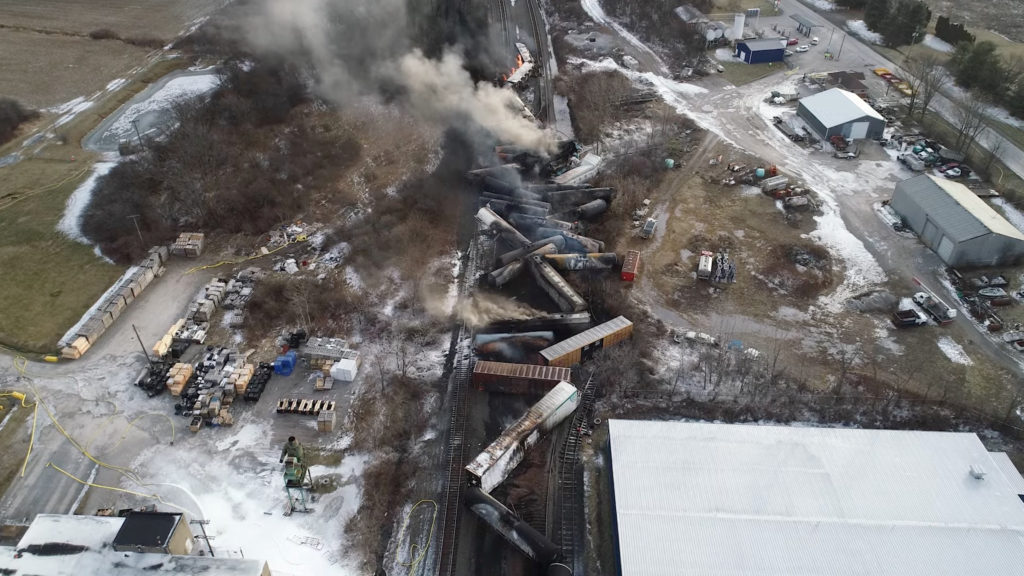Ohio Train Derailment: Toxic Chemical Lingering In Buildings For Months

Table of Contents
The Extent of Chemical Contamination
The February 3rd derailment in East Palestine, Ohio, released a cocktail of toxic chemicals, including vinyl chloride, butyl acrylate, and ethylene glycol monobutyl ether. These substances are known carcinogens and can cause a range of severe health problems, from respiratory issues and skin irritations to long-term organ damage and cancer. The initial controlled burn of vinyl chloride, intended to prevent a catastrophic explosion, further exacerbated the spread of toxic fumes and pollutants.
- Specific locations: Contamination remains high in residential areas, schools, and businesses within a significant radius of the derailment site. Specific locations are still being identified through ongoing testing.
- Detection methods: The Environmental Protection Agency (EPA) and other agencies are employing various methods, including air and water sampling, soil testing, and analyzing residential dust samples, to detect and measure the presence of these chemicals. However, concerns persist about the comprehensiveness and transparency of these efforts.
- Scale of contamination: The exact number of buildings affected remains unclear, highlighting the limitations in current testing and assessment. Estimates indicate that hundreds of buildings may be impacted, leaving a large population exposed to potentially hazardous levels of toxins.
- Data on contamination levels: Data released by the EPA and other agencies show varying levels of contamination, with some exceeding safe thresholds. However, the full extent of the contamination and its long-term persistence remain unknown. Access to consistent and complete data remains a crucial concern for affected residents.
Long-Term Health Impacts on Residents
Residents near the derailment site have reported a range of health problems, raising serious concerns about the long-term health impacts of exposure to these toxic chemicals. The symptoms reported are consistent with exposure to the chemicals released.
- Reported illnesses: Numerous residents have reported headaches, respiratory problems (coughing, shortness of breath, wheezing), skin rashes, nausea, and eye irritation. Specific statistical data on the prevalence of these illnesses are still being compiled and analyzed.
- Medical monitoring: While some medical monitoring is underway, access to comprehensive and consistent healthcare for those affected remains a challenge. The long-term effects of exposure to this specific mixture of chemicals are not fully understood.
- Psychological impacts: The ongoing uncertainty about the extent and longevity of the contamination and the potential for long-term health consequences have had a significant psychological impact on the community, creating widespread anxiety and stress.
- Credible sources: The CDC and ATSDR (Agency for Toxic Substances and Disease Registry) websites provide information on the health effects of vinyl chloride and other chemicals released in the derailment, though further research is necessary to understand the combined impacts of this specific chemical mixture.
Environmental Consequences and Cleanup Efforts
The Ohio train derailment has caused significant environmental damage, impacting the soil, water, and air quality in the surrounding area. The long-term effects on the local ecosystem are still unfolding.
- Cleanup operations: Ongoing cleanup efforts involve removing contaminated soil and water, but the scale and effectiveness of these operations remain a subject of debate and ongoing monitoring.
- Effectiveness of cleanup: The long-term effectiveness of the cleanup methods used is yet to be determined, and the potential for groundwater contamination and long-term soil pollution remains a considerable concern.
- Environmental monitoring: Long-term environmental monitoring plans are in place, but concerns linger about the frequency and thoroughness of testing and transparency with the community.
- Ecosystem impact: The impact on local waterways, wildlife, and plant life needs ongoing assessment to understand the true extent of the ecological damage caused by the spilled chemicals.
Government Response and Accountability
The government's response to the derailment and subsequent cleanup efforts has been heavily criticized for its perceived slowness, lack of transparency, and insufficient support for affected residents.
- Shortcomings in initial response: The initial response was criticized for its perceived delays in evacuating residents and providing clear and accurate information about the dangers of the released chemicals.
- Legal actions and investigations: Several lawsuits have been filed against Norfolk Southern, the railway company responsible for the derailment, and investigations into the causes of the derailment and the adequacy of the response are underway.
- Preventing future derailments: While some measures are being discussed to prevent future derailments, robust and comprehensive changes to railway safety regulations are necessary.
- Financial assistance: While some financial assistance has been offered, the adequacy and accessibility of this support for affected residents remain questionable, requiring further investigation and support.
Conclusion
The Ohio train derailment released toxic chemicals that continue to linger in buildings months later, causing significant health concerns and environmental damage. The long-term effects remain uncertain, and the government's response has been heavily criticized. The lack of transparency and complete data on the extent of the contamination raises serious questions about public safety and environmental protection. We need to demand further investigation into the lingering effects of the Ohio train derailment toxic chemicals, call for increased transparency from authorities, and push for stronger regulations to prevent future incidents. Support organizations providing assistance to affected residents, stay informed about the latest developments, and demand accountability for those responsible. Use keywords such as "Ohio train derailment cleanup," "Ohio train derailment health effects," and "Ohio train derailment investigation" to encourage further engagement and research. The future health and well-being of the community depend on it.

Featured Posts
-
 The Zuckerberg Trump Dynamic Implications For Social Media And Beyond
Apr 27, 2025
The Zuckerberg Trump Dynamic Implications For Social Media And Beyond
Apr 27, 2025 -
 Three Year Trend Canadian Enthusiasm For Evs Continues To Fade
Apr 27, 2025
Three Year Trend Canadian Enthusiasm For Evs Continues To Fade
Apr 27, 2025 -
 February 16 2025 Open Thread Conversation
Apr 27, 2025
February 16 2025 Open Thread Conversation
Apr 27, 2025 -
 Ariana Grandes Dramatic Hair And Tattoo Transformation Exploring The Significance
Apr 27, 2025
Ariana Grandes Dramatic Hair And Tattoo Transformation Exploring The Significance
Apr 27, 2025 -
 The Psychology Behind Celebrity Transformations Ariana Grandes Bold Style Choice
Apr 27, 2025
The Psychology Behind Celebrity Transformations Ariana Grandes Bold Style Choice
Apr 27, 2025
